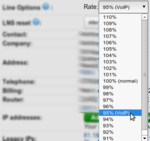Other Line Options: Difference between revisions
mNo edit summary |
mNo edit summary |
||
| Line 9: | Line 9: | ||
==FastTimeout== |
|||
Uses a PPP LCP Echo timeout of 10 seconds rather than 60 before entering the LostCarrier state. |
|||
'''More info:''' LCP echoes usually stop responding if the line has gone down. Our LCP monitoring, which produces the graphs will drop the line if there are no replies after 60 seconds. When [[bonding]] or used in a fall-back setup, having a faster timeout is useful in order to fall-back quicker. |
|||
Revision as of 11:20, 25 February 2015
Rate
This sets the download (internet to you) speed on the AA routers.
At 100%, the LNS throttles you to exactly your line's capacity. At 110%, it will let through 110% of your line capacity, and allow the wholesaler's systems to buffer/drop the excess. At the 95%, it lets through 95% of the line's capacity, so it will unaffected by the wholesaler's buffering. Setting to less than 100 is advised for lines running VoIP and other realtime services as it means the downlink won't be filled. Lowering the rate from 100% (e.g. to 95%) will mean that there should be no network buffering within the wholesalers network - and may well reduce latency when downloading at the full rate of the line.
FastTimeout
Uses a PPP LCP Echo timeout of 10 seconds rather than 60 before entering the LostCarrier state.
More info: LCP echoes usually stop responding if the line has gone down. Our LCP monitoring, which produces the graphs will drop the line if there are no replies after 60 seconds. When bonding or used in a fall-back setup, having a faster timeout is useful in order to fall-back quicker.
